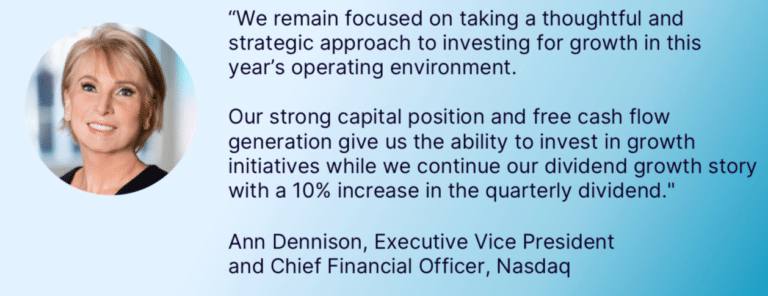

Adena Friedman, chair and chief executive of Nasdaq, highlighted the potential of generative artificial intelligence across its businesses as the exchange has made a regulatory filing for its first AI-driven order type – Dynamic M-ELO.
Friedman spoke on Nasdaq’s first quarter 2023 results call on 19 April. She said that in the first quarter there was a generational technology breakthrough with the emergence of generative artificial intelligence tools.
“While the debate surrounding generative AI use cases needs time to evolve, it is clear to us that companies that have invested in modern technologies, including cloud architecture and deployment, modern APIs and machine learning are poised to take advantage of this new era of technological advancements,” she added. “ At Nasdaq we’ve been focused on investments to modernize our technology across our businesses and therefore we are well positioned to incorporate more advanced AI capabilities in the future.”
Friedman argued that Nasdaq has been very intentional in migrating critical workloads and capabilities into a cloud environment with modern APIs to support client connectivity and functionality, and has also built unique datasets across various business areas, which are foundational to using AI.
“While we’re just beginning the process of evaluating specific ideas for the use of generative AI in our products and across our business operations, we see compelling opportunities to leverage broader AI models, including deep reinforcement learning, predictive control, and computer vision across our business divisions and to support our strategic efforts to enhance the liquidity, transparency and integrity of the financial ecosystem,” Friedman added.
For example, Nasdaq is already using AI and machine learning in its anti-financial crime business in combination with advanced data sets to improve the efficiency of the banking industry’s daily compliance processes, achieve a step change in their ability to detect and stop money laundering and reduce false positives.
Nasdaq is also already using predictive AI for capacity planning for its market infrastructure and dynamically managing its servers, and using machine learning to help manage strikes across its options markets. Other examples are Nasdaq using AI for intelligence ESG data scraping to help bring more information to corporates and to provide them with more insights into their ESG characteristics and their peers, and using natural language processing to help its analysts write reports for clients.
Dynamic M–ELO
Friedman said: “In our market platforms division, we are in advanced stages of new product developments that incorporate AI including new dynamic order types that improve our clients’ fill rates while minimising market impact. We have submitted our first AI-based market order for regulatory approval which is context aware, so it is designed to incorporate awareness of market conditions on a real-time basis.”
In 2018 Nasdaq introduced the M–ELO order type, a non-displayed order priced at the midpoint between the National Best Bid and Offer (NBBO) which was only eligible for execution against other eligible M–ELOs and after a minimum holding period of 0.5 seconds from when the system accepted the order. The following year Nasdaq introduced the M–ELO+CB, which closely resembles the M–ELO, but can execute against a wider range of eligible orders. After studying two years of the use and performance of M–ELOs, and in response to customer feedback, the holding period was cut to 10 milliseconds in 2020 after approval from the US Securities and Exchange Commission.
"Technological innovation is an unstoppable force," says $NDAQ CEO @adenatfriedman. "AI is a tool. It can be used for good and bad purposes. With the potential for bad use cases, it's incumbent on firms like ourselves to use that technology to protect against bad players." pic.twitter.com/DRw9lyzfyk
— Squawk Box (@SquawkCNBC) April 19, 2023
The SEC said in the Federal Register on 13 April 2023 that Nasdaq now proposes to further refine the length of the holding periods for M–ELOs and M–ELO+CBs using “innovative and patent pending machine learning technology” as it has found that shorter periods could achieve the same, if not better results for participants in terms of mark-outs, although not in periods of heightened price volatility.
“In light of these observations, the exchange tasked its artificial intelligence and machine learning laboratory to explore whether it could employ these innovative technologies to optimize the length of M–ELO and M–ELO+CB holding periods during various states of price volatility, and then to vary the lengths of the holding periods dynamically during the lifecycles of M–ELOs and M–ELO+CBs, with the objectives of improving the performance of these order types while also further reducing opportunity costs,” added the SEC. “Through a process of learning and experimentation involving a combination of historical and simulated data, the AI Core Development Group settled on a Dynamic M–ELO model that achieved substantial simulated performance improvements for users of M–ELO and M–ELO+CB—both in terms of mark-outs and fill rates—as compared to the static 10 millisecond holding periods.”
Dynamic M–ELO yielded an average combined volume-weighted (simulated) improvement of 31.7%, including a 20.3% increase in fill rates and an 11.4%reduction in mark-outs. Nasdaq intends to make the proposed change in the second or third quarter of this year, but that time frame is subject to change.
Trading services
Total net revenues for the first quarter of 2023 were $914m, an increase of 2% from the prior year period.
Friedman said: “Our first quarter financial performance illustrates the progress we have made to capitalise on certain growth opportunities that are aligned with three key trends that we believe are shaping the financial system.”
These three trends are the modernisation of markets, the development of the environmental, social and governance (ESG) ecosystem and the increasing need for advanced anti-financial crime technology.
Trading services net revenues were $267m, a 1% increase from a year ago, which Nasdaq said reflected strong growth from North American trading, partially offset by a decline in European trading. Nasdaq said it led all exchanges in total multiply-listed options traded in the first quarter and that it has maintained a consistent share of available on-exchange U.S. equity trading since the first quarter of 2022, with improving capture contributing to revenue growth.
Friedman added that Nasdaq is continuing its cloud migration strategy. The core trading system of MRX, one of Nasdaq’s six options markets, migrated to Amazon Web Services (AWS) edge cloud last year. Nasdaq plans to migrate a second options exchange by the end of this year, and is currently migrating its surveillance and BoardVantage SaaS solutions to the cloud.
MRX experienced a 10% improvement in latency after moving to the cloud and Friedman said the venue has increased market share by providing a more deterministic trading experience.
“We have a plan over the next several years to continue that migration,” she added. “This market modernisation opens up opportunities for new order types, new capabilities, as well as a more scalable infrastructure which will start to show some real cost savings over time.”
The firm is also waiting for regulatory approval from The New York State Department of Financial Services before launching its Digital Asset business, and Friedman said they are hopeful of getting approval in this quarter. Nasdaq wants the product to be ready by the end of this quarter and aims to begin user testing in May.
“Nasdaq will be getting engaged more generally in the crypto space as regulation starts to come into the market,” she added. “We have an ability to come in with a resilient and very scalable solution.”
Friedman asserted that Nasdaq’s crypto custody is a real improvement in technology as it involves a continuous wallet that is always available but incredibly secure, which will be more attractive to institutional users that need continuous access.
Anti-financial crime revenue increased 17% compared to the first quarter of 2022. Nasdaq signed its first global Tier 1 bank to its fraud detection and anti-money laundering SaaS solution in April 2023, as well as another Tier 2 client during the period.






